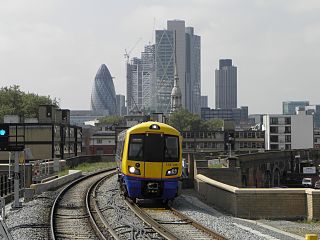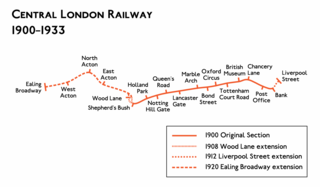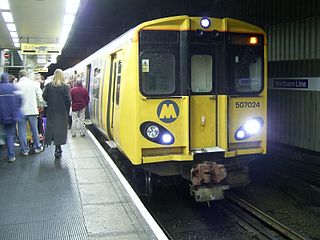
The East London line is part of the London Overground, running north to south through the East, Docklands and South areas of London. It was previously a line of the London Underground.

The Queensway tunnel is a road tunnel under the River Mersey, in the north west of England, between Liverpool and Birkenhead. Locally, it is often referred to as the "Birkenhead tunnel" or "old tunnel", to distinguish it from the newer Kingsway tunnel (1971), which serves Wallasey and the M53 motorway traffic. At 3.24 kilometres (2.01 mi) in length, it is the longest road tunnel in the UK.

Merseyrail is a commuter rail network serving the Liverpool City Region and adjacent areas of Cheshire and Lancashire. Merseyrail operates 66 railway stations across two lines – the Northern Line and the Wirral Line, which are dedicated 750 V DC third rail electrified lines converging into rapid transit-style underground sections in the centres of Liverpool and Birkenhead. Merseyrail branding is also applied to stations and ticketing on the City Line, which are within the Liverpool City Region but operated by other train operating companies, predominantly Northern Trains. The City Line services operate on the Liverpool to Manchester Lines and the Liverpool to Wigan Line using a mix of AC electric and diesel trains.

The M20 is a motorway in Kent, England. It follows on from the A20 at Swanley, meeting the M25, and continuing on to Folkestone, providing a link to the Channel Tunnel and the ports at Dover. It is 50.6 miles (81.4 km) long. Although not signposted in England, this road is part of the European route E15. It is also used as a holding area for goods traffic when traffic across the English Channel is disrupted, such as Operation Stack and Operation Brock.

Wapping or Edge Hill Tunnel in Liverpool, England, is a tunnel route from the Edge Hill junction in the east of the city to the Liverpool south end docks formerly used by trains on the Liverpool-Manchester line railway. The tunnel alignment is roughly east to west. The tunnel was designed by George Stephenson with construction between 1826 and 1829 to enable goods services to operate between Liverpool docks and all locations up to Manchester, as part of the Liverpool and Manchester Railway. It was the first transport tunnel in the world to be bored under a city. The tunnel is 2,030 metres (1.26 mi) long, running downhill from the western end of the 262 metres (860 ft) long Cavendish cutting at Edge Hill in the east of the city, to Park Lane Goods Station near Wapping Dock in the west. The Edge Hill portal is near the former Crown Street Station goods yard. The tunnel passes beneath the Merseyrail Northern Line tunnel approximately a quarter of a mile south of Liverpool Central underground station.


The Central London Railway (CLR), also known as the Twopenny Tube, was a deep-level, underground "tube" railway that opened in London in 1900. The CLR's tunnels and stations form the central section of the London Underground's Central line.

The Calder Valley line is a railway route in Northern England between the cities of Leeds and Manchester as well as the seaside resort of Blackpool. It is the slower of the two main rail routes between Leeds and Manchester, and the northernmost of the three main trans-Pennine routes.

The Oxted line is a railway in southern England and part of the Southern franchise. The railway splits into two branches towards the south and has direct trains throughout to London termini.

Liverpool Exchange railway station was a railway station located in the city centre of Liverpool, England. Of the four terminal stations in Liverpool's city centre, Exchange station was the only station not accessed via a tunnel.

Merseytram was a proposed light rail system for Merseyside, England. Originally proposed in 2001, forming part of the Merseyside Local Transport Plan, it was to consist of three lines, connecting the Metropolitan Borough of Knowsley with central Liverpool. The project was postponed due to funding problems before eventually being formally closed down by Merseytravel in October 2013.

The Woodhead line was a railway line linking Sheffield, Penistone and Manchester in the north of England. A key feature of the route is the passage under the high moorlands of the northern Peak District through the Woodhead Tunnels. The line was electrified in 1953 and closed between Hadfield and Penistone in 1981.

The Merseyrail Northern line is a cross-city railway running from Hunts Cross in south Liverpool then to termini in the north at Southport (Merseyside), Ormskirk (Lancashire) and Kirkby (Merseyside). It and the Wirral Line are commuter rail services operated by Merseyrail, serving Merseyside. A third line, the City Line, is not owned or operated by Merseyrail, although stations inside Merseytravel's area are branded as Merseyrail. All three lines are funded by Merseytravel.

The Wirral line is one of two commuter rail routes operated by Merseyrail and centred on Merseyside, England, the other being the Northern line.
The North Liverpool Extension Line was a railway line in Liverpool, England in operation between 1879 and 1972. It was at one stage intended to become the eastern section of the Merseyrail Outer Loop, an orbital line circling the city.

The Liverpool–Wigan line is a railway line in the north-west of England, running between Liverpool Lime Street and Wigan North Western via St Helens Central station. The line is a part of the electrified Merseyrail Liverpool to Wigan City Line. The stations, and all trains serving it, are operated by Northern Trains, however the stations are branded Merseyrail using Merseyrail ticketing.

The Great Central Main Line (GCML), also known as the London Extension of the Manchester, Sheffield and Lincolnshire Railway (MS&LR), is a former railway line in the United Kingdom. The line was opened in 1899 and built by the Great Central Railway running from Sheffield in the North of England, southwards through Nottingham and Leicester to Marylebone in London.

The Gravesend West Line was a short railway line in Kent that branched off the Swanley to Chatham line at Fawkham Junction and continued for a distance of 5 miles (8 km) to Gravesend where the railway company constructed a pier to connect trains with steamers. It was opened in 1886 and closed to passenger services in 1953, remaining open to freight until 1968 before reopening briefly between 1972 and 1976. Part of the railway's former alignment was incorporated into the Channel Tunnel Rail Link.
Heathrow Hub railway station was a proposed interchange that would serve – mainly – a now disbanded potential alignment of High Speed 2 (HS2) services that would adjoin the expanded part of Heathrow Airport, England. It was a cornerstone part of an expansion plan put forward in 2008, by engineering firm Arup, to set up the UK's first high-speed rail network north-west of London.

The Llangurig branch was a part of a proposed scheme by the Manchester and Milford Railway (M&MR) to connect industrialised Northwest England with the West Wales deep water port of Milford Haven. After various financial and construction difficulties, the 1.5 miles (2.4 km) of the Llangurig branch is noted as being the shortest lived working branch line in the United Kingdom, receiving only one train.


















